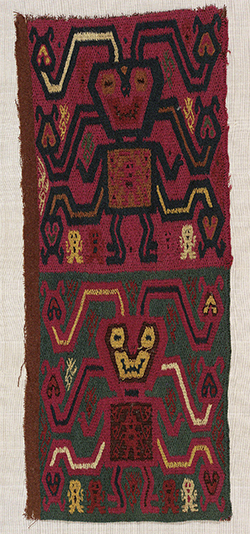Ancient Peruvian Fiber Art: Paracas Culture
Over the years, I have gone through periods of intense fascination for a variety of art forms. Have you ever found yourself thinking, “If I weren’t a painter, I’d be a glass artist” or the like? I do that all the time. One of my many moods has been, “If I weren’t a painter, I’d get a loom and be a fiber artist.”
Mr. Kapheim, my high school art teacher, tried to introduce us to a variety of media disciplines, but he encouraged us to focus on one and get it right. My love of fiber arts has never abated, and one of my absolutely favorite periods of fiber art is from the ancient Americas, specifically Peru. Compare this piece with textiles from any other culture from the same period, and I’m sure you’ll agree that ancient Peruvian textiles rank towards the top in color, form, and sophistication.
 |
| Paracas Culture (flourished ca. 1400 BCE–540 CE, Peru), Fragment of a textile, ca. 100 BCE–100 CE. Cotton and camelid fibers, 13 ½" x 5 ½" (34.3 x 14 cm). © Museum of Fine Arts, Boston. (MFAB-302) |
The textiles of ancient Peru, woven in every known technique for over three thousand years, represent the highest achievement of their civilization. Textiles were the most highly prized objects after gold in Peruvian cultures. Most Peruvian textiles were produced on simple backstrap looms.
The Paracas culture was located on the south coast of Peru. The name translates from the Quechuan dialect to “sand falling like rain,” due to the frequent sandstorms characteristic of the area. The Paracas elevated textile art to some of its highest levels of sophistication, and had the longest continuous tradition of textile art in history. In fact, textiles were developed to a high degree of refinement long before ceramics (the Paracas also developed improvements in the kiln-firing of ceramics). Textiles were used for trading purposes, commemorated attainment of certain societal rank (such as attaining adulthood), used to mark a person’s status or achievements, and celebrated familial events. Thousands of Peruvian textiles have come down to us because the mummified bodies of Paracas society were wrapped in multiple layers of cloth on burial.
The Paracas believed that nature and humankind shared the same attributes of the spiritual world. While many textiles display animal forms, there are many, like this example, that seem to blur the boundaries between human and animal. Such forms are called “anthropomorphic,” or “zoomorphic.” The dry climate of the Peruvian coast helped to preserve the large numbers of textiles seen in museums today. The period of production of this beautiful piece roughly coincides with the Roman Empire in Europe, the Nok culture in Nigeria, and the Han Dynasty in China.


Comments